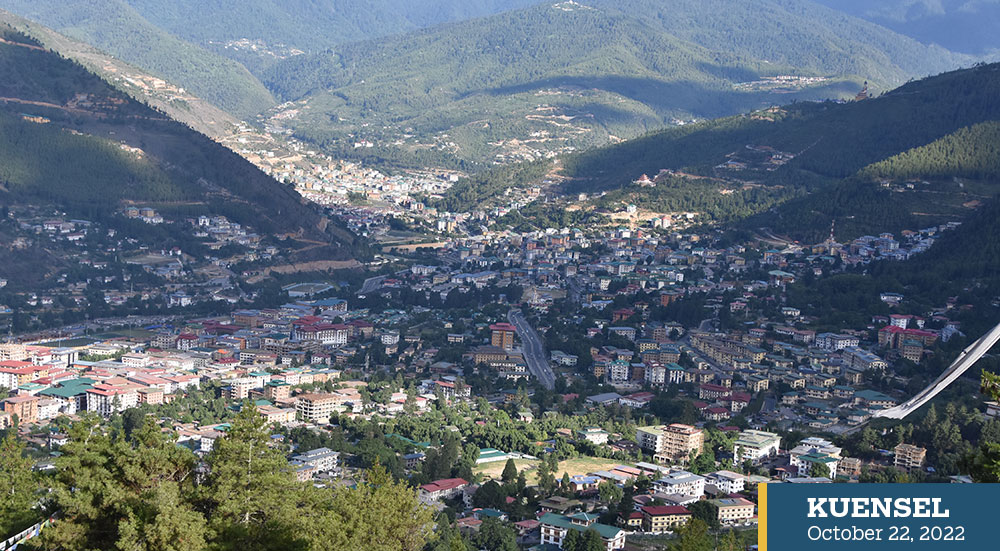Land lease rate not revised since 2009
Thimphu Thromde could generate annual revenue of about Nu 7.14 million (M) if leased or one-time revenue of about Nu 976M if sold from the residual land in the Thimphu urban core (UC), a Centre for Bhutan and GNH Studies research found.
The revenue was calculated congruent to the Property Assessment and Valuation Agency (PAVA) rate. Residual land is land that cannot be allocated to proposed new plots or used for infrastructure or services as per the land pooling and readjustment regulation 2018. Conversely, residual land is commonly proposed as green space or service plots in the planning process, but often never implemented on the ground for its proposed use. Hence, adjacent plot owners take advantage of and use it as parking, gardening, or dumping space.
Titled ‘Investigating Viability and Values; Residual Land in Thimphu Thromde,’ the study found out that there are 8.2 acres of residual land existing in the Thimphu UC area which extends from Lungtenzampa bridge to the Royal Textile Academy (RTA) in the north. When evaluated at the market rate, residual land in the UC area is worth about Nu 2 billion.
The study assessed these areas with recent topography and infrastructure survey data from the department of human settlement. The data overlapped with the cadastral map and each residual land was extracted separately for area calculation. For land valuation, land lease rule and regulation 2009 were referred for lease rate and land compensation rate/PAVA 2017 for selling value which was further juxtaposed with the market rate of the real-estate companies in Bhutan.
Contrary to the UC area which grew long before the formulation of the Thimphu structure plan (TSP), a well-planned and plotted local area plan (LAP) in south Thimphu, particularly pertaining to Simtokha LAP, a total of 19 acres of land is still underutilised comprising of endowment area and patches of residual land. Residual lands which were demarcated as service plots and green space was undeveloped. The study found that these lands were usually encroached on by private structures where a few have utilised the areas as parking spaces.
Given the opportunity, the thromde could lease these developable endowment areas along with the residual land allocated as service plots. As per the data analysed, leased land would help generate a revenue of about Nu 4.1M per annum on the existing PAVA rate, and if sold at a current market rate, it could generate one-time revenue of about Nu 24.7M.
Similarly, the study also found that squatters were built in environmental precincts in the Dechencholing/Dangrina LAP. Some patches of service plots were dumped with construction materials and a few were used as parking spaces and kitchen gardens. Considering the viability of leasing patches of these residual and service plots to the adjacent land owner along with the lease of developable areas in the environmental precinct, thromde would have potentially generated a revenue of about Nu 1M per year.
Time to revise regulations
While it is worth noting that the study emphasised the exploitation of land resources by a handful, and exploration on generating local urban government revenue attributing to developable land as the most valuable asset for the private or the government, the study also reviewed specific regulations related to land and land valuations.
It was concluded that the revision of PAVA or the land compensation rate 2017 was due in 2020 since the revision needs to be carried out every three years according to the Land Act 2007. However, it was not. Similarly, the land lease rate was not revised since 2009 which should have been revised twice by 2019.
“The delay in the revision of such regulations incurred a heavy burden to the government because the market price and inflation keep soaring aiding land speculation and the misuse of government land resources,” the study found.
The purpose of land valuation in the study is for an assessment and to indicate a ballpark in terms of monetary value, and not to prompt any authority for selling government land. Besides, the Land Act prohibits land transactions of government land other than the exchange of land within government institutions. The revision of the Land Act 2007 could consider amending the definition of the government institution land.
While the land transfer tax record maintained by the Thimphu Thromde for thromde land reflected that 20 percent of the land transfer carried out from 2017 to 2021 had zero value, 2.5 percent had a value less than the existing PAVA rate. It is, therefore, vital to re-assess the methodology and mechanism of land transfer tax and data-keeping. A consistent valuation methodology and framework for assessing land value to retain accurate data and minimise land speculation reform is urgent now, more than ever.
In assessing the land ownership type in Thimphu Thromde, it was found that the maximum plots were owned by individuals followed by government institutions, and family land. A total of 456.4 acres (7%) of the residual land area was found within the thromde boundary, not considering the roads and environmental precincts or the buffer areas.
The seven percent residual land in the thromde could probe relevant agencies to determine if the misuse of land was from data keeping or in planning and management. Applying arithmetic means for the urban land compensation rate in PAVA 2017, the value of residual land in the thromde would amount to about Nu 8.13B and has the potential to generate about Nu 99M per annum if leased.
Contributed by Yangchen Lhamu
Researcher
Centre for Bhutan & GNH Studies


